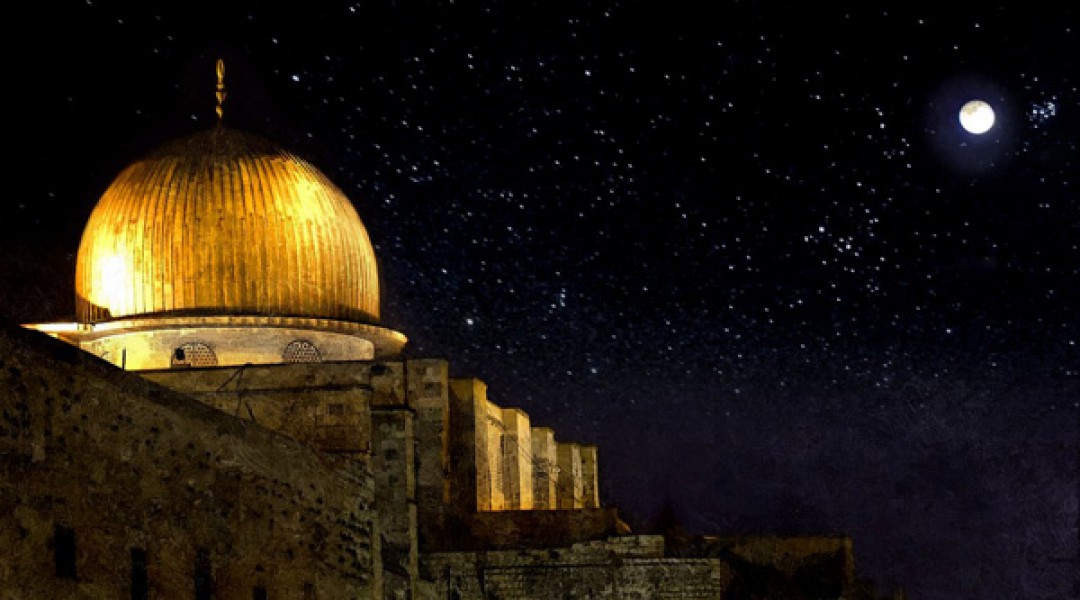Exalted is He who took His Servant by night from al-Masjid al-Haram to al-Masjid al- Aqsa, whose surroundings We have blessed, to show him of Our signs.
[Qur’an 17:1]
As we prepare for the month of Ramadan, Muslims the world over celebrate the Prophet Muhammad’s (May peace be upon Him) night journey from Makkah to al-Aqsa (Israa) and the ascension through the heavens (Mi’raaj).
On his return to Makkah, at the age of 51, Allah honoured the Prophet with the night journey. Some say that at the time of the event, the messenger was in the Hijr in Makkah while others say that he was in his home.
As Muslims, we are obligated to believe in the journey of the Israa which is a mutawatir narration, while the Mi’raaj, which is a strong but ahad narration, is considered by some scholars as not obligatory to believe. Therefore, if someone does not agree with the Mi’raaj, we cannot claim that they are out of the fold of Islam.
Those who accept the Mi’raaj cite the ayah in the Qur’an that provides recourse for the Nabi when the Quraish mocked his description of the sight of angel Jibraeel during the Mi’raaj.
The ayah states (which may mean): “So will you dispute with him over what he saw? And he certainly saw him in another descent. At the Lote Tree of the Utmost Boundary. Near it is the Garden of Refuge. When there covered the Lote Tree that which covered [it]. The sight [of the Prophet] did not swerve, nor did it transgress [its limit]. He certainly saw of the greatest signs of his Lord. [Quran 53: 12-18]
The journey of the Israa and Mi’raaj
The Prophet travelled from Makkah to Jerusalem with the use of a Buraaq, a word that originates from the word Barq, which means ‘light’. The Nabi is, therefore, described as having travelled with the speed of light from Makkah to Jerusalem, where the journey of Mi’raaj began.
As the Prophet ascended the heavens, he met with numerous Anbiya (prophets) and at each level he was met by an angel who took permission of entry.
The Prophet ascended to the Sidrat al-Muntaha (the lote tree of the furthest limit), where Jibraeel said: “I cannot go any further than that.”
The Prophet proceeded beyond the Sidrat al-Muntaha where he received the commands of Allah.
There is contention with regard to whether the journey was a physical or spiritual experience. The dominant opinion is that this was a physical experience. There is, however, an opinion that the Prophet’s experiences took place in another realm.
Shaykh Hamza Yusuf describes the events of the Israa and Mi’raaj as being outside of human comprehension.
“Which is why it is called the Sidrat al-Muntaha that is beyond which the intellect can grasp,” Shaykh Yusuf explains.
The Qur’an states that the Prophet’s eyes were not diverted by the wondrous things around him, nor did it transgress beyond that. The prophet was singularly focussed – “To your lord is the end.” [Qur’an 53:42]
Why the Prophet Muhammad did not physically see Allah
The opening of the verse that describes the Israa begins with the word “Subhaan”, which is interpreted as: ‘Allah, you are free from non-befitting attributes and non-suitable attributes.’
Though many describe the Mi’raaj as an event in which the Prophet saw Allah in the physical form, this is not in keeping with the basic tenants of Aqeeda, which confirms that Allah is not a physical body. According to these principles, Allah is not confined to a space or a place and exists in entirety with no beginning and no end.
The view of Ahlus Sunnah is that he experienced the presence of the Almighty, as Allah’s attributes are not restricted to human qualities.
Therefore, the objective of the journey through the heavens was to reveal to the Prophet some of the miracles of Allah.
Since Allah is the Creator of the creation, Muslims are reminded to refrain from describing Allah within the restrictions of human consciousness and to avoid adopting the interpretations of anthropomorphist’s.
“That was not a meeting ground. It is simply a place where Allah willed the Rasool to receive the command of Salah and to see the place that no other creation has seen,” as explained by Shaykh Yahya Al-Ninowy.
The proof of this, in Sahih Muslim, where Saydinah Aisha is narrated to have said: “Whoever says that the Prophet has seen his Lord, he is lying to you.” She subsequently recited an attribute of Allah: “Visions can never see Him, yet He sees all visions.”
This example, therefore, indicates that a distinction should be made when interpreting the attributes of the Almighty, specifically with regard to the interpretation of the events that unfolded on the night of Israa and Mi’raaj.
VOC






 WhatsApp us
WhatsApp us 

